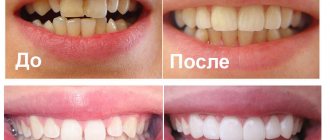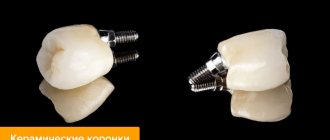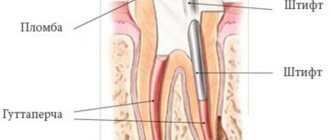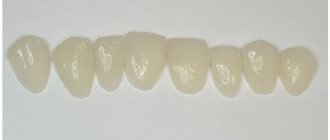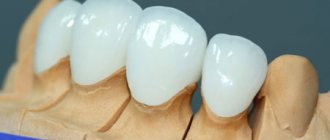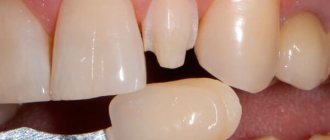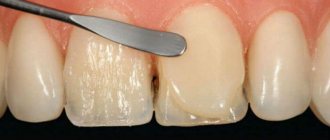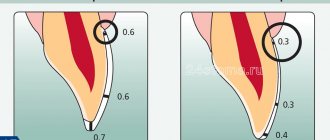The aesthetics and beauty of a smile have acquired particular relevance in modern society and have become a certain indicator of a person’s success. However, naturally straight and perfectly white teeth are an incredible rarity, occurring in no more than 5% of people. For everyone else, aesthetic dentistry and one of its developments—ceramic veneers—can help in achieving an impeccably beautiful smile. In the article we will talk in detail about what ceramic veneers are, in what cases they are used and what advantages they have. We will also tell you about the cost of the service: the price of making a ceramic veneer for 1 tooth.
Calculate the cost of treatment by taking a short test in 20 seconds!
Do not delay your treatment, because in this matter time plays against us.
Ceramic dental veneers: what are they?
Veneers are a dental term that refers to microprostheses for the front surface of teeth, used to eliminate aesthetic defects in the dentition in the smile area. Such overlays can be made from different materials, but the choice of professionals and most patients at the moment is ceramic veneers. The use of ceramic veneers in aesthetic restoration will allow you to quickly achieve a beautiful smile, and its appearance will be flawless.
Such ideal aesthetics cannot be achieved by other technologies: teeth whitening and restoration with composite materials. And therefore, the number of positive reviews about ceramic veneers is constantly growing.
The advantages of using ceramic veneers also include:
- There is no need for preliminary tooth depulpation with nerve removal.
- Environmental friendliness of ceramic veneers: the onlays are made from a material that is safe for human health, cannot provoke allergic reactions, is biocompatible with the tissues of the human body, and does not emit harmful substances during operation.
- Ready-made ceramic veneers have excellent strength, reliability and aesthetics and a maximum useful life.
Ceramic veneers do not lose transparency and do not stain or change color under the influence of external factors. The price of ceramic veneers in Moscow is high, but taking into account all the listed advantages, it is completely justified. If you want a Hollywood smile, you can create it with the help of ceramic veneers and the specialists of our Vanstom dentistry! Below we post photos of ceramic veneers: pictures before and after the procedure for installing microprostheses will help you evaluate the results of the restoration and decide whether you should choose this particular technology for yourself. You can get a detailed consultation on ceramic veneers by visiting our clinic. Our address: Moscow, Baumanskaya metro station, st. Bakuninskaya, 17/28.
Treatment of dental caries with a microscope
Large fillings in chewing teeth were installed a long time ago; many fillings are no longer airtight, so caries has developed under the fillings. Dentist-endodontist T.I. Matienko treated dental caries using a microscope.
The use of a microscope helps treat caries microinvasively, removing only tissue damaged by caries and preserving tooth tissue as much as possible. After caries treatment, the teeth were restored with light-cured composite fillings. In the future, the teeth will be covered with crowns, which will strengthen them and prevent splitting due to high chewing load.
Types of ceramic veneers
Ceramic veneers are also called metal-free veneers, since no metals are used in their production, which makes it possible to use this type of microprosthesis for dental restoration in people who have allergic reactions to metal alloys. The material for making ceramic veneers is dental porcelain, which in its basic characteristics resembles natural tooth enamel.
Thanks to the unique properties of dental ceramics, microprostheses made from it do not lose their ideal whiteness and translucency under the influence of negative external factors and have the longest possible useful life. Ceramic veneers can be produced using two different technologies, the features of which we will discuss below.
Refractory method
This technology for creating ceramic veneers is also called layer-by-layer. The microprosthesis is created in layers, each of which is exposed to high temperatures to bake and achieve maximum strength of the finished ceramic veneer. Ceramic refractory veneers are valued for their high aesthetics: the layer-by-layer creation method allows you to obtain a plate with a color that will be similar to the shade of the enamel of natural teeth.
Pressing
The pressing technology in the manufacture of ceramic veneers makes it possible to obtain ready-made microprostheses, not only with optimal strength and reliability indicators: it is this technique that is used for the manufacture of ultra-thin E-max ceramic veneers. The essence of the technique is to create, under pressure and high temperatures, an ultra-thin plate of dental porcelain, which is then qualitatively polished and glazed to give the finished structure a pleasant natural shine.
Microprostheses made of zirconium dioxide are considered a separate type of ceramic veneers. They have a special two-layer design, the base of which is a zirconium plate. The outer surface of the veneer is covered with ceramics and polished. The use of a zirconium frame in the design of a ceramic veneer allows us to obtain a microprosthesis of increased strength; it will be much stronger and more durable than plates produced by pressing. Accordingly, the cost of ceramic veneers with a zirconium base will be higher.
Manufacturing of ceramic veneers
The production of ceramic veneers is laboratory in nature. The dentist only takes impressions of the prepared (ground) teeth and passes them on to the dental technician. The procedure for making the onlay takes no more than a few days, during which time the patient is given temporary veneers. Temporary veneers will hide tooth defects, avoid discomfort while eating, and protect teeth from destruction by microorganisms.
At the next session, the same dentist will place onlays on the teeth and fix them. All specialists who take part in this procedure are highly qualified doctors with extensive practice. The goal of their work is to give your smile an extraordinary charm, to restore and maintain the health and strength of your teeth.
Sometimes specialists are faced with the fact that the manufactured veneers either do not suit the patient or cause him discomfort. In this case, they are sent for revision. Only after comfortable products are obtained are they fixed to the patient’s teeth.
Healthy teeth and good health
FDC will be a pleasant find for you and your family on the path to impeccable aesthetics and good health.
Indications and contraindications for ceramic veneers
The installation of ceramic veneers is indicated in the presence of the following conditions and circumstances:
- Unattractive shape of teeth, abnormal direction of growth of dental units.
- Changes in the color of tooth enamel that cannot be removed by traditional whitening methods.
- Stains, noticeable cracks and chips on dental surfaces.
- Curvature of teeth, mild bite defects that do not require orthodontic correction using braces.
Despite a significant number of advantages and versatility in solving various kinds of aesthetic problems, the installation of ceramic veneers has not only indications, but also contraindications. It is impossible to use ceramic veneers if the patient has hypertonicity of the masticatory muscles of the oral cavity, in the absence of units performing the chewing function. Ceramic veneers are not recommended for people whose profession or lifestyle is associated with an increased risk of injury: athletes, stuntmen.
Ceramic veneers are not used for untreated caries that has caused severe destruction of teeth, for the presence of large fillings, or for abnormal occlusion. In case of severely damaged teeth or the absence of units in the rows, it is recommended to first undergo prosthetic or implantation procedures and only then install ceramic veneers on healthy teeth whose aesthetics require correction.
Dental prosthetics with crowns and veneers
Based on digital modeling, temporary dental crowns and veneers were made. The teeth are prepared for crowns and covered with temporary restorations. While the patient wore temporary crowns and veneers, she was able to understand how comfortable everything was for her and whether she liked the new shape of her teeth. There were no comments, so the permanent crowns were made using the same digital model.
Crowns and veneers for teeth and implants are made of E.max ceramics, shade Bleach. Ceramic restorations replicate the properties of tooth enamel - they have the same transparency and shine. The new smile is perfect.
The photographs show the appearance of teeth from different angles before and after ceramic prosthetics:
Veneers were installed on the six upper and six lower front teeth, and crowns were installed on the remaining teeth and two implants in the lower jaw.
Due to a shortage of soft tissue in the area of implants previously installed in another clinic, it was not possible to completely hide the junction of the abutment (the base for the crown installed on the implant) and the crown. The patient was warned about this result, but she was happy with everything, since this area is not visible when smiling.
A complete smile change took only 2.5 months.
The cost of dental prosthetics with ceramic crowns and veneers, including dental treatment with a microscope, amounted to 1,451,500 rubles.
Dial-Dent specialists who performed this work:
- Orthopedic dentist – diagnostics, treatment planning, coordination of the work of other specialists, temporary prosthetics, ceramic dental prosthetics.
- Implant surgeon V.P. Alaverdov – removal of wisdom teeth.
- Dentist-endodontist T.I. Matienko – replacing old fillings and treating dental caries with a microscope.
- Dental assistants A. Antoshkina, E. Sheiko.
See other examples of the work of Family Dental specialists here.
Make an appointment for a consultation by phone +7-499-110-18-04 or through the form on the website. You can ask questions about dental prosthetics to the chief doctor of the clinic, Sergei Vladimirovich Tsukor, at
The main stages of the procedure for installing ceramic veneers
Restoration of smile aesthetics using ceramic veneers takes place in several main stages:
- Examination at the dentist's office. During the examination, the specialist examines the condition of the patient’s oral cavity, identifying contraindications to the installation of ceramic veneers. Before the procedure, caries must be treated and old composite fillings must be replaced, as well as high-quality sanitation of the oral cavity.
- The dentist determines the color of future ceramic veneers using a specialized scale for this purpose. Ceramic veneers can be made with a color similar to natural tooth enamel, but the specialist will also take into account the individual wishes of the patient regarding the whiteness and transparency of the finished ceramic microprostheses.
- Preliminary grinding of dental surfaces for installation of ceramic veneers. It is performed with a special instrument and during the procedure, a layer of enamel up to 1 millimeter thick is removed from the surface of the tooth.
- A 3D impression is taken of the patient’s teeth and sent to the dental laboratory. Based on this impression, an individual set of ceramic veneers will be made for the patient.
- For the time it takes to make ceramic veneers, the patient is fitted with temporary microprostheses made of plastic. This design will make the appearance of ground dental units aesthetic and, in addition, will protect their surface from the action of negative external factors.
The final stage of restoration is the installation and fixation of permanent ceramic veneers. Microprostheses are fixed to dental surfaces using special dental cement, and it is extremely important that the doctor selects the correct color of the composition. Ceramic veneers are translucent, and therefore the aesthetics of the microprosthesis fixed to the teeth will depend on the shade of the cement.
How are veneers classified by shade?
A dentist who selects veneers can be compared to an artist - after all, he needs to very accurately select the shade with their finest gradation. Its “palette” includes 16 shades of dental overlays, which have a clear classification and marking in Latin letters and numbers. This is called the VITA scale. By the marking you can immediately tell what color we are talking about and eliminate mistakes.
- The Latin “A” stands for veneers that have a brownish-red hue. This does not mean that they are really the color of fresh brick - no, only a tiny drop of this color is mixed into the white, that is, the final color can be called a pale pale powdery.
- “B” is a reddish-yellow color (that is, a little orange in the white).
- “C” is a grayish shade: it is the coldest in the entire available palette.
- "D" is a mixture of reddish and gray shades.
But these are only colors - and in each of them there are also 4 different saturation options, that is, how large a proportion of the chromatic color is present in pure white. They are designated by numbers from 1 to 4. For example, the marking may look like this: “C3” - and this means that we are talking about a grayish tint of medium saturation.
Comparison of dental onlays made from other materials
Ceramic veneers in Moscow are in demand among patients, but this is not the only option for microprostheses that modern dentistry can offer a patient. Veneers can also be composite; lumineers are a separate type of overlay. To make the right choice in favor of one type of veneer or another, it will be useful to study the features of each type.
Composite veneers
Let's start our comparative analysis by examining a relative budget option - composite veneers.
Let’s say right away that a comparison of ceramic and composite veneers will not be in favor of the latter option. Composite or direct veneers are created from light-curing filling materials and are not made in laboratories - the dentist restores dental surfaces with composite veneers directly in the patient’s mouth. This technique has advantages - an affordable price and the ability to eliminate aesthetic defects in the shortest possible time, but at the same time, composite veneers are not reliable and durable, and their aesthetic indicators are also low.
It is not possible to achieve a snow-white smile with the help of composite veneers - all composites have a slightly yellowish tint, and in addition, the surface of such overlays quickly changes its color due to external factors and after about two years they will have to be replaced.
Free consultation on the cost of treatment in our dentistry
Leave a request and the clinic administrator will contact you within 15 minutes!
Zirconium veneers
We have already talked about zirconium dioxide veneers above; they are worth choosing if you are interested not only in the aesthetics of the result of dental restoration, but also in its maximum reliability. The zirconium frame, on which a layer of ceramic is applied, makes the finished structures capable of withstanding various types of loads.
Lumineers
An innovation in aesthetic dentistry is lumineers, which can be considered a separate type of ceramic veneers, since the material used for their production is the same dental porcelain.
The difference will be in thickness; lumineers are an ultra-thin type of ceramic plates and therefore their installation will not require preliminary grinding of tooth enamel. Lumineers are not fixed with cement, but with a special original composition that ensures fastening strength and, in addition, contains fluoride, which has a positive effect on dental units and strengthens them.
The minimum thickness of lumineers should not alarm the patient: this type of ceramic veneers is produced using a special technology that ensures their strength and long service life - up to 20 years! Not only will the ceramic plate not change color from contact with coloring foods and drinks, it can flawlessly withstand mechanical stress and contact with aggressive substances.
Lumineers are often chosen for restoration by famous people and stars of the world of music and cinema, which is why their second name is Hollywood ceramic veneers. The price of ceramic veneers in this option will be as high as possible, but fully justified by their impeccable performance and aesthetic characteristics.
We hope that our short comparative analysis of the types of veneers will help you make the right choice, and you can always get more detailed and professional advice on ceramic veneers and their installation at our dental clinic in Moscow - Vanstom! Come to our specialists for a personal appointment, we are located in the center of Moscow, next to the Baumanskaya metro station.
Service life of ceramic veneers
The durability of ceramic veneers - this characteristic of microprostheses made of dental porcelain has been repeatedly tested in clinical trials. Tests carried out in laboratory studies showed the following results: almost 90% of ceramic veneers placed on dental surfaces without overlapping the cutting edge retained all their useful characteristics and properties for seven years or more. It has also been proven that overlapping the incisal edge when installing porcelain veneers increases their durability several times.
The average service life of high-quality ceramic veneers manufactured and installed with strict adherence to technology is about 15 years. Lumineers have a longer useful life - up to 20 years. Cheap composite veneers cannot boast of such indicators, which have to be replaced at best five years after installation, as they crack, change color and can break off.
It is important to note that the durability of ceramic veneers will largely depend on how correctly and regularly the patient cares for the oral cavity and teeth after the restoration procedure. By following all the recommendations of the dental clinic specialists, you will extend the useful life of ceramic veneers, and the aesthetically impeccable restoration result will last for a long time.
Service life and care of ceramic veneers
With proper hygiene and periodic dental checkups, porcelain veneers can last for more than ten years. Don’t forget that, just like your own teeth, dental veneers also require care. With proper care, their cost turns out to be completely low, because they will serve you for a very long time.
The lifespan of veneers depends on how the patient cares for them. To do this, after the operation, the dentist gives the patient some recommendations:
- Teeth should be thoroughly cleaned daily with a toothbrush and floss. Maintaining good hygiene minimizes the accumulation of plaque and the risk of caries (caries can occur in those parts of the tooth that are not covered with veneer);
- Porcelain veneers are designed to improve the appearance of a tooth. They cannot withstand significant loads or force. These forces can cause the veneer to break or become dislodged.
Oral hygiene after installation of ceramic veneers
There is no need to perform special and complex oral hygiene procedures after installing ceramic veneers, but it is extremely important that care is thorough and regular. After installing ceramic veneers, you should limit the amount of excessively hard foods in your diet and definitely give up the bad habit of chewing anything with your teeth - for example, nuts or candy.
When playing sports and active recreation, you need to avoid injuries in the jaw area and be sure to protect yourself from hypothermia and overheating. The surfaces of teeth restored with ceramic veneers should be cleaned with pastes without abrasive particles in the composition, and also do not forget to use dental floss and balms-rinses in oral hygiene.
Don’t forget about regular visits to the dentist’s office for preventive examinations. Caries and other dental diseases that are not detected in a timely manner may require the removal of plates from the surface of the teeth and reinstallation after treatment. And this is a very serious financial expense that can be avoided by following the simple recommendations that we have given for you in this section of the article.
Wisdom teeth removal
The wisdom teeth on the lower jaw have long been filled. Currently, treatment of wisdom teeth is impractical, since they do not have antagonists, that is, teeth on the opposite jaw. The removal of the two lower wisdom teeth was performed by implant surgeon V.P. Alaverdov.
Do I need to undergo therapeutic treatment before installing ceramic veneers?
If an initial examination by a dentist reveals that you have caries or other dental diseases, they will need to be eliminated before ceramic veneers are installed. It is imperative to carry out high-quality sanitation of the oral cavity, since a specialist will need to evaluate the natural color of the enamel of your teeth to create sets of veneers. And to do this, you need to thoroughly clean the dental surfaces from bacterial plaque and hard dental deposits.
Is the procedure painful?
Patients who are afraid to visit the dentist's office for fear of pain need not worry - the installation of ceramic veneers is a procedure that does not cause severe pain. Moreover, the process of adaptation to microprostheses also occurs quite quickly. Once accustomed, there are no problems with diction; you can start eating as usual immediately after installing microprostheses. Some discomfort may occur when grinding down tooth enamel, but light anesthesia before the procedure will help to avoid them.
Calculate the cost of treatment by taking a short test in 20 seconds!
Do not delay your treatment, because in this matter time plays against us.
Ceramic veneers: price per tooth
The price of ceramic veneers depends on a number of factors: on what type of microprostheses you choose, on production technology, on the need for additional therapeutic measures before installing veneers. Ceramic veneers are expensive: their cost is higher than composite microprostheses, but lower than the prices for lumineers. The price of a ceramic veneer in our Vanstom clinic is from 14,000 rubles. But as has been repeatedly noted above, the costs of restoration are compensated by its excellent results, speed and durability.
You can find out the exact cost of the service for installing ceramic veneers at any time convenient for you by contacting our dentistry in Moscow - Vanstom. We offer our patients first-class dental services at realistic prices and guarantee high quality of their performance!
